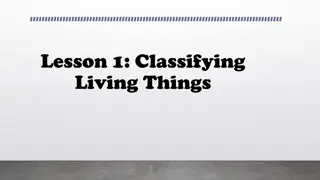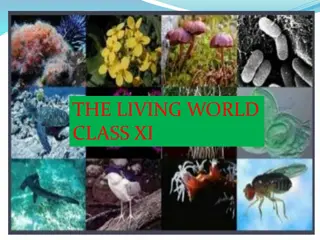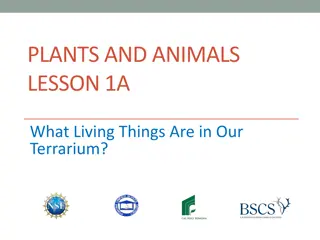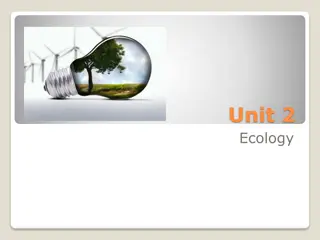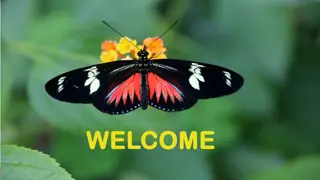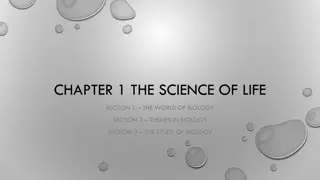Understanding the Characteristics of Living Things
Living things, known as organisms, exhibit essential characteristics including being made of cells, requiring nutrition, excreting wastes, responding to changes in their surroundings, and reproducing. They are classified into different groups such as bacteria, fungi, plants, animals, and others like protists. These groups showcase a diverse array of living organisms with unique characteristics and functions.
Download Presentation

Please find below an Image/Link to download the presentation.
The content on the website is provided AS IS for your information and personal use only. It may not be sold, licensed, or shared on other websites without obtaining consent from the author. Download presentation by click this link. If you encounter any issues during the download, it is possible that the publisher has removed the file from their server.
E N D
Presentation Transcript
The characteristics of all living things Characteristic Meaning Cells The basic building blocks of living things Nutrition The way in which living things get their food Excretion The way in which living things get rid of wastes that they produce Response The way in which living things react to changes in their surroundings Reproduction The way in which living things produce new living things
The characteristics of all living things Living things (called organisms) must have all of the following features: o made of cells
The characteristics of all living things Living things (called organisms) must have all of the following features: o they need nutrition (or food)
The characteristics of all living things Living things (called organisms) must have all of the following features: o they must have excretion (getting rid of any waste that they make)
The characteristics of all living things Living things (called organisms) must have all of the following features: o they must respond (they react to changes in their surroundings)
The characteristics of all living things Living things (called organisms) must have all of the following features: o they must be able to reproduce (form new living things).
Different types of living things To make it easier to find music on Spotify it is classified (or grouped) into headings, such as new releases or what s hot or compilations. In the same way, living things are classified into groups.
Different types of living things In general there are five major groups of living things, as shown below: Group of living things Examples Bacteria Tiny microscopic living things. Some cause disease, some cause decay, some are used to produce valuable substances Fungi Mushrooms, moulds and yeast Plants Trees, grasses, flowers Animals Humans, fish, insects Others (Protists) Seaweeds, amoeba
Different types of living things Each of the five groups can be sub-divided into many smaller groupings. For example, animals can be classified as: o Vertebrates animals that have backbones (e.g. horse, seagull, frog, snake)
Different types of living things Each of the five groups can be sub-divided into many smaller groupings. For example, animals can be classified as: o Invertebrates animals that do not have backbones (e.g. spider, worm, fly, jellyfish).
The diversity of living things Biodiversity means the range of living things. There is a huge range (or diversity) of living things on Earth. For example, there are many different types of plants, birds, fish and insects. Each of these living things needs special conditions in which to grow. Unfortunately, many of these conditions are being lost due to human activities. For example: o Woodlands are destroyed for housing and roads. o Forests are being lost to supply wood for building. o Lakes are destroyed by pollution. The resulting loss of biodiversity will be examined in chapter 12.
Cells Living things are made of cells. Cells are the basic building blocks of all living things. Most cells are too small to be seen with the naked eye. They can be seen only using a microscope. Cells can divide to form two cells. This is called cell division. Living things grow by cell division. For example, humans grow from a single cell (called a zygote) by cell division. As a result, an adult human has a hundred million million cells.
Animal cells Animal cells have three main parts: Cellmembrane Nucleus Cytoplasm
Animal cells Animal cells have three main parts: Cellmembrane (thin layer that surrounds cell): o holds the contents of the cell in place o controls what passes in and out of the cell.
Animal cells Animal cells have three main parts: Nucleus (a round structure that controls the cell): o contains chromosomes o chromosomes contain genes o genes are made of DNA o genes control features such as eye colour and ability to form finger nails o genes are passed on from parents to offspring.
Animal cells Animal cells have three main parts: Cytoplasm (a liquid that surrounds the nucleus): o carries out some cell reactions o contains small structures such as mitochondria (for energy).
Plant cells Plant cells have five main parts: Cell wall Nucleus Cell membrane Cytoplasm Vacuole
Plant cells Plant cells have five main parts: A cell membrane (a thin layer that surrounds the cell): o holds the contents of the cell in place o controls what passes in and out of the cell.
Plant cells Plant cells have five main parts: A nucleus (a round structure that controls the cell) o contains chromosomes o chromosomes contain genes o genes are made of DNA o genes control features such as petal colour and the shape of the leaves o genes are passed on from parents to offspring.
Plant cells Plant cells have five main parts: Cytoplasm (a liquid that surrounds the nucleus): o carries out some cell reactions o contains small structures such as chloroplasts (for photosynthesis).
Plant cells Plant cells have five main parts: Vacuole (a small liquid- filled bag in the cytoplasm): o gives strength to plant cells.
Function and location of cell structures Cell structure Cell membrane Function Found in Retains cell contents Controls what passes in and out of the cell Animals and plants Nucleus The control centre of the cell Animals and plants Cytoplasm Carries out some cell reactions Supports tiny cell structures Animals and plants Mitochondrion Supplies energy to the cell (by respiration) Animals and plants Cell wall Gives strength to the cell Plants only Chloroplast Makes food (by photosynthesis) Plants only Vacuole Gives strength to the cell Plants only
The light microscope A microscope is used to view objects that are too small to be seen by eyesight alone. The term magnification means how many times larger the object appears to be when viewed under the microscope.
The parts of a microscope Eyepiece lens Coarse focus knob Nosepiece Fine focus knob Objective lens Clip Stage Mirror (or light)
Activity 2.1 How can we examine animal cells? Prepare the slide 1. Gently scrape the inside of your mouth with the cotton wool bud (or the wooden spatula). 2. Scrape the saliva (which now contains cheek cells) onto the centre of a microscope slide. 3. Add three or four drops of methylene blue stain to the saliva (this stain highlights parts of the cell, especially the nucleus).
Activity 2.1 How can we examine animal cells? Prepare the slide 4. Lower a cover slip slowly at a 45 degree angle over the cheek cells as shown above. 5. Use tissue paper to soak up any of the stain that may be outside the cover slip.
Activity 2.1 How can we examine animal cells? Viewing the slide under a microscope 1. Switch on the microscope light (or adjust the mirror so that light is shining through the opening in the stage of the microscope). 2. Turn the nosepiece so that the lowest power objective lens is in place. 3. Place the slide in the centre of the microscope stage and use the clips to hold it in place.
Activity 2.1 How can we examine animal cells? Viewing the slide under a microscope 4. Look at the stage from the side and turn the coarse focus knob so that the low power objective lens moves as close as possible to the slide. (Be careful with the lens.) 5. Look through the eyepiece and turn the coarse focus knob slowly so that the cells become visible. If necessary, move the slide slightly so that you can see the best sample of cells. 6.
Activity 2.1 How can we examine animal cells? Viewing the slide under a microscope 7. Draw a diagram of the cells that you can see. Label the three main parts of one of the cells. 8. Turn the nosepiece to a higher power lens and use the fine focus knob to get a clear image of one of the cells. Draw this cell and label three main parts. 9.
Activity 2.1 How can we examine animal cells? Viewing the slide under a microscope 10. Observe the cheek cells for features such as: o Are they all the same shape? o Are they all the same size? o What colour is the cytoplasm? o What colour is the nucleus? o Can you see any particles in the cytoplasm?
Photo credits Michael Philips QBS









